![Three Ways To Build Your Client and Networking Base]()
by Ashley Oslund Altamirano | Feb 5, 2015 | Business, Communication, Events

Whether you are starting out or are well-established, keeping your business going is not always a walk in the park. There is so much to consider but perhaps the most central concern is that of getting your name out to the general public. There are several ways to do this, each with their own particular pros and cons. Your dog training business’s success will depend on your ability to be recognized. There is no better way to do this than by NETWORKING and ‘oh my gosh’ it can be daunting task. However, once you get past the initial shock of the concept, you’ll find that it’s actually quite easy.
Recommended Reading: Why You Should Do Some Market Research Before Starting Your Dog Training Business
Reaching Out To Fellow Dog Trainers
The way I started networking is what I have termed ‘going in cold’. I directly emailed nearby trainers (to the North, South and West of me) whose philosophies and training styles most resonated with me. I still remember the first email I sent asking to meet up for coffee or lunch. I regretted hitting the send button almost immediately! But my fears were quickly put to rest. I had failed to realize how warm and willing to help out a well-qualified and experienced dog trainer could be. Thank you John, Linda and Pat for replying to my random invite for coffee! That one little reply email was the stepping-stone for me to connect with other trainers and learn the ropes. It was free and best of all has led to the development of awesome friendships and professional contacts. Even more, the relationships I went out on a limb and created allowed me to learn about how I wanted certain aspects of my own business to be. They even led to my first referrals and clients.
Now the ‘going in cold’ networking method isn’t the only way to gain recognition. You can accomplish the same by going through a paid organization, specifically ones like your local Chamber of Commerce or private associations like Business Network International. They both will cost you up front but they do have the potential to drum up solid business leads and turn you into a permanent fixture in your local community.
Related: Check out our “Mastermind Meetups for Modern Dog Trainers” and request one in your area!
Join Your Chamber Of Commerce
The most familiar of the two is the local Chamber of Commerce. They typically work to increase your business’s visibility by listing your company on their exclusive business directory. Basically a digital Rolodex accessible via the chamber’s website to help customers find relevant services. They also publish monthly, quarterly, and or annual newsletters that feature local business and community activities. Typically you pay a fee to advertise in them. This cost is independent of the membership price, which can either be a flat rate (typically $400 plus) or a scaled fee. The scaled rate is dependent on the size or type of business, e.g. professionals and large corporations being charged the highest. Most all Chamber of Commerce advertise that they will increase your business’s exposure and recognition. For the most part they do deliver on that promise as is documented by a 2012 research study conducted by the Schaprio Group. They determined that membership is seen as “an effective business strategy” by 59% of consumers. More important for dog trainers is how the study indicates that people will see your business as one that both employs “good business practices” and is “reputable” within the community.
The benefits of being a member are not just limited to customer’s perception or being listed in a directory. The hidden value extends from the meaningful face-to-face relationships you will create with local professionals. Through sponsored business mixers and social events (business conferences or luncheons) you will get to know the businesses in your area in person. It is at these events you can make contact with service providers that you, as a business owner, might be in need of–like a quality accountant, photographer, or pet friendly real estate agent. Before you take the leap, keep in mind that programs and service are not all the same. So check with your town’s local Chamber of Commerce for specifics at the US Chamber of Commerce Directory.
Become A Member Of BNI
Another well-known organization focused on improving business success by way of networking is Business Network International. BNI is based on the idea that “givers gain” and founded by Dr. Ivan R. Misner in 1985. Each chapter creates a concentrated environment for professionals and local business owners to interact and direct potential customers between them through word-of-mouth marketing. It is quite effective when utilized.
BNI will let you attend a local chapter before joining in order to get a better feel for what they offer. In my case, I attended a meeting that averaged about an hour in length. My sponsor (who invited me) asked that I have ready a 60 second bio about myself, my business, and what goals I have. While a 60 second introduction may feel like a trial by fire, it actually was a great icebreaker as chapter members have had the same experience at one point in their careers. There are some particular rules to be aware of when attending. For instance, each local chapter is limited to only one member of a particular profession/business. This means that there will be only one lawyer, one mechanic, or one dog trainer within the group; however there can be multiple chapters within a city. You can visit a group for FREE twice before deciding whether or not you want to join! Much like the Chamber of Commerce, you will get the chance to gain inside access to professional services that are needed by business owners. In the chapter I belong to I connected with a CPA and a professional photographer that will be a phenomenal help to my business. The carpet cleaning company is also in my sights 😉
In the end the possibilities are boundless when it comes to successful networking. Networking is about getting to know your neighbors and building relationships so you can both succeed. So however you get it done – it will certainly help you out in the long run. Where and how have you had the best experiences networking? Are you a member of any business organizations?
Get Dog Training Business Tips!
Receive valuable dog training business tips and resources every week! Subscribe to The Modern Dog Trainer now by submitting your name and email below.
[mc4wp_form]
![Three Ways To Build Your Client and Networking Base]()
by Thomas Aaron | Feb 3, 2015 | Business
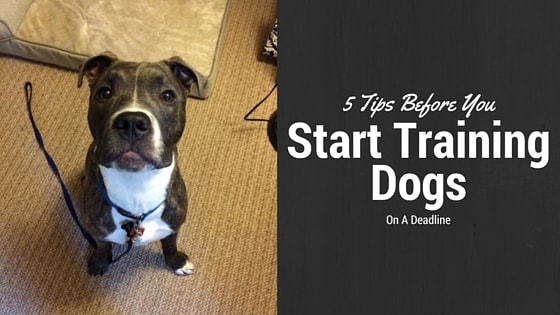
Five Things To Consider
There are numerous ways for dog trainers to provide their services, and each has its benefits and drawbacks. In addition to group classes, in home training, and day training services, trainers also can provide board-and-train services.
For clients, having their dogs boarded and trained usually is more expensive than other modes of training, but it is a viable option for those who have hectic schedules and find attending group classes or scheduling private coaching unfeasible. (As trainers, we often become agitated about clients who cannot make time to train their dogs. However, board and train services can lay important groundwork with the dog and can be used in conjunction with in-home training or group classes to help busy clients achieve their training goals more efficiently.)
But before you decide to add board and train services to your repertoire, there are several factors you should consider.
Training Dogs On A Deadline
Board and train usually is faster than group classes or private training, because it pushes the dog towards new training objectives daily rather than weekly. Additionally, the training is being performed by professional trainers, who should have better timing and tactile skills than the average dog owner. For those reasons, some people are willing to pay you a premium to accomplish training goals, but they are not willing to give you their dog indefinitely. They will expect you to complete your training goals on a deadline.
For example, while a Level One Obedience course may take five or six weeks in a group class or in-home training scenario, it usually takes no more than two weeks in a board-and-train environment (for the reasons mentioned above). However, there is a certain stress factor involved in working on a deadline that does not lend itself to successful positive reinforcement training.
It is easy to deal with problems and various training interruptions early in the board-and-train process. But problems are not as easy to handle as the training deadline draws closer. Dogs do not learn faster just because you need them to. Your stress level can complicate their learning ability (as they are emotional creatures). So, trainers who offers board-and-train services must understand how to manage their stress levels and patiently keep the training process moving forward.
Getting Results With Dogs, Not People
If a dog is not making progress in a group class or in-home training environment, there are lots of possible reasons. You could blame the owner for not putting in the effort or not following your advice. You could blame the owner’s children for constantly reinforcing the dog’s bad habits. You could even blame the dog … let’s face it, they are not all easy. However, in a board-and-train environment, all blame rests on the trainer if the job does not get done correctly, and clients will not accept excuses unless they are accompanied by a refund.
Remember, boarding-and-training is about training dogs, not people. It requires a person who can train animals effectively and efficiently, not a personal coach. To be sure, there is an overlap in skill-sets in the two disciplines, but those offering board-and-train services cannot exempt themselves from responsibility if the dog does not get trained well and on-time.
Note: While it is possible to negotiate extending a dog’s training time in your program, you must lay a pretty good argument for it, preferably earlier in the dog’s stay with you rather than later.
Skills Training Versus Behavior Modification
In truth, behavior is behavior. Sitting is a behavior. Coming when called is a behavior. Walking calmly on a leash in the presence of other dogs is a behavior. Exhibiting separation anxiety when the owner leaves the home is a behavior — one we would like to eradicate. However, some behaviors are more feasible to work on in a board-and-train environment than others.
A fundamental rule for boarding-and-training is this: If a behavior is not heavily dependent on the dog’s owner, family or environment (that is, if it is just a skill), it probably can be created or modified effectively in a board-and-train program.
Chasing the cat, house training, leash aggression, resource guarding toys from the children, fighting with the other dog in the family and separation anxiety are all examples of behaviors that are difficult to fix in a board-and-train environment. This is because, in one way or another, they all have specific links to the dog’s environment and family.
Now you could do some groundwork on many of these issues in a board-and-train environment (i.e. some impulse control work, some socialization, some counterconditioning, teaching leash walking), but you most likely will not be able to solve the dog’s problem without some follow-up work with the dog’s family in their home environment.
While there are indeed some trainers who specialize in fixing certain complex behavior issues in a board-and-train environment, skills training is where the average board-and-train program can really shine. Sit, down, stay, come, leave it and leash walking are all examples of simple skills that can easily be taught to an acceptable degree in a short timeframe. Board and train can also be a great way to teach certain work- and game-related skills: retrieving, nose work, protection work, hunting, agility. These are not so dependent on the dog’s family and environment; they are just things the dog can know how to do and enjoy.
Setting Expectations And Offering Handover Sessions
There is what a dog knows, and then there is what a dog does — and the two are not always linked. For example, a dog may know how to come when called, but that doesn’t mean he will be willing to in every circumstance. Also, dogs seem to learn that it is rewarding to listen to some people and not to others. For these reasons, it is important to set expectations correctly with owners. You must tell the owner that you will teach their dogs skills and demonstrate those skills when they come to pick up their dog, but you also must explain that some work with them will also be necessary.
The first formal training the owner gets when they pick up their dog should be a very detailed handover session. You might want to compliment the session with handouts that describe everything their dog was taught, proper cues and related hand positions, important principles to follow, etc.
However, many board-and-train specialists sell their board and train package so that it includes one or (optimally) more in-home sessions to help the owner get the hang of handling their newly trained dog, managing the dog correctly, and reinforcing the dog’s newly trained behaviors.
And The Legalities
Some trainers maintain professional facilities where they provide board-and-train services. Such facilities usually must be regulated by one or more governmental entities. For example, in Colorado a boarding facility must be licensed by the Department of Agriculture and by the city government. It also must be well insured, as a lot can go wrong when dogs and people are involved.
Other trainers like to provide board-and-train services in their home. This option can be particularly attractive to clients, as most people would rather have their dog trained in a cushy home rather than a kennel. For this reason, it also is attractive to trainers (in addition to the fact that a home has much fewer operational expenditures than a facility).
However, there are a few things you should check on before deciding to offer boarding and training at your home. First, you will want to determine the degree to which you must submit to regulatory and licensing authorities. Second, you will want to make sure you are not running amok of your community covenants. And third, you will want to make sure your insurance will cover it.
Clients may not think of these things while times are good. But if something goes wrong (and it probably will, according to Murphy’s Law) and they decide to sue you, you can be sure that all of these things will be brought to light, and your reputation as a professional will rest on how well you have adhered to them.
Do you offer board-and-train options? If so, what other factors do you think are important to consider?
Get Dog Training Business Tips!
Receive valuable dog training business tips and resources every week! Subscribe to The Modern Dog Trainer now by submitting your name and email below.
[mc4wp_form]
![Three Ways To Build Your Client and Networking Base]()
by Erin Bessey | Jan 28, 2015 | Business
Ask anyone and they have their own idea of what a dog should learn. There are the essential behaviors but there are some other behaviors that might not be taken into consideration until there is an issue. It is important to cover these in a class to provide students with a proper foundation for a well-behaved and stable dog.

Image via Bessey’s Positive Paws
1. Sit
An essential behavior that most clients have already started with their dog when they come to class but is still just as important to cover. Sit is key to get as a solid behavior because it can be utilized when working on proper greetings or providing a dog with an incompatible behavior to jumping.
2. Down
Another essential behavior that clients like to know how to teach. It works as an incompatible behavior to things like jumping but also is handy when working on teaching place or a settle.
3. Leave-it
A behavior that has endless uses. Not only to teach a dog to leave food or inanimate items but other dogs, cats, people or “yuck”. You can fill in the blank.
Whether a dog is allowed freedom outdoors or not, how to walk on a leash is a behavior to start immediately. There will always be a time when a dog needs to be put on a leash and it is more pleasurable for dog and handler when the leash is loose, let alone safer.
Clients tend to focus their attention on exercising their dog which can lead to an anxious or hyperactive dog that doesn’t know how to chill. Dogs will adapt to the level of exercise they are given. We need to teach them to settle and relax in the face of excitement or boredom.
6. Recall
Also known as “coming when called,” this is a life saving behavior and takes lots of practice to be truly successful. Coming when called is a key behavior to teach early on in lessons. Consider incorporating a hand touch with this behavior to make sure the dog comes within reach in case of an emergency situation.
7. Place
A versatile tool like a mat, towel, dog bed etc. that can be used to have the dog target at a specific location and then to relax and settle. Mats are portable and can be taken to coffee shops or restaurants as well.
8. Focus
Client will repeat cues to a dog when they don’t even have the dogs attention. By teaching the client this tool of gaining their dogs attention will help to eliminate frustration in the face of distractions.
9. Handling
Teaching your clients to teach their dogs to love handling is essential. It helps to create a stable, confident dog. Dogs should allow their owners to comfortably hold their feet (for nail trimming), check their mouth, look in their ears, brush their coats and accept restraint. Having strangers perform these exercises to the dog is a definite bonus to prep for vet visits! (Tip: Have everyone in class switch dogs and practice gentle handling exercises with lots of rewards.)
10. Give
Teaching “give” or a “drop it” helps prevent resource guarding. Instead of forcing something away from the dog we can give the dog the choice to drop the item for something of better value.
The above behaviors are listed in no particular order to importance. Which behavior do you think is the most important?
![Three Ways To Build Your Client and Networking Base]()
by Liz Wyant | Jan 15, 2015 | Business
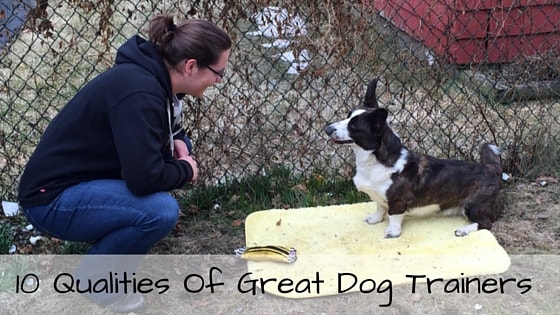
There are many dog trainers in this world. Some are amazing, some are so-so, and let’s be honest, some are downright dodgy. As a modern dog trainer, what are some traits you should possess to be considered a great dog trainer?
1. Patience
Patience is indeed a virtue, is it not? Especially when dealing with clients and their dogs. Maintaining your patience is key to helping clients learn without feeling like you are getting annoyed with them. They didn’t understand your directions the first three times? No problem, you’re willing to explain it again because you are patient and you understand that people and dogs learn at different rates.
2. Sense of Humor
Maybe this should have been number one? On those days where it feels as though everything is going wrong and like the dogs are out to make you feel like a failure of a dog trainer, keep that sense of humor. Learn to keep it light-hearted. If you get frustrated, nobody benefits.
3. Creativity
Dog trainers all have their standard ways of teaching tasks. What happens when the dog or client just isn’t getting it though? You get creative! You use butt scratches (for the dog, not the client!) as rewards. You completely revamp the environment so the dog can succeed. You use interpretive dance to explain a technique to a client. In short, you get creative to get things done!
4. Flexibility
Not necessarily physical flexibility (though let’s be honest, when an untrained mastiff is launching himself cheerfully at your head to say hello, some gymnastic skills can come in handy!), but more mental flexibility. Sometimes you will get a client that just does not want to do something the way you want them to do it. Not out of lack of understanding, but just because they don’t want to. Be flexible. Pick and choose your battles and work around your client’s desires.
5. Confidence
Have some faith in yourself! So often, dog trainers downplay their skills and training. I would bet that your clients think you are fantastic. I would bet that your fellow trainers think you are fantastic. You’ve put a lot of work into your training skills and business, so be confident about talking yourself up.
6. Humility
On the flip side, keep it humble. Don’t be a braggart. But mainly, do not take on clients that are over your head. There is no shame in saying, “you know, I’m not qualified to help you, but let me recommend you contact so and so!” People respect that. And honestly, it will keep you, your clients, and their dogs safer.
7. Open Mind
You can learn a lot from other trainers, even those who do things differently than you do, or even those who use techniques you’d never use (or will no longer use, if you are a crossover trainer). You can learn something from everybody if you just keep an open mind.
8. Diplomacy
Tact can be difficult. But you need to keep that internal filter on your mouth working. Blurting out, “you’re an abusive person for using a collar like that!” will not gain you any clients, nor will it help change any minds. Try instead, “I used to use those collars, too. They certainly do work, but do you know about the potential issues that can arise from their use?” Remain non-judgmental and be careful in your wording. That old adage of catching more flies with honey than vinegar is true.
9. Tolerance for Being Dirty
If you are a neat freak, you may be in the wrong field. Between dirty paws, slobber, dog hair, and residue from stinky treats being wiped on your pants, you don’t have a dream of staying clean!
10. Hoarder of Dog Equipment
Perhaps this is just much-needed justification for never getting rid of anything, but sometimes it can really come in handy! Having equipment on hand (different types of no-pull harnesses, head collars, flat collars, martingales, muzzles, etc) to show as examples to clients can help make things clearer for them. Also, since all dogs are shaped differently, sometimes one type of equipment will fit better than another. One size does NOT fit all when it comes to dog equipment.
So what qualities do you think great dog trainers should possess?
Get Dog Training Business Tips!
Receive valuable dog training business tips and resources every week! Subscribe to The Modern Dog Trainer now by submitting your name and email below.
[mc4wp_form]
![Three Ways To Build Your Client and Networking Base]()
by Kat Camplin | Jan 2, 2015 | Business
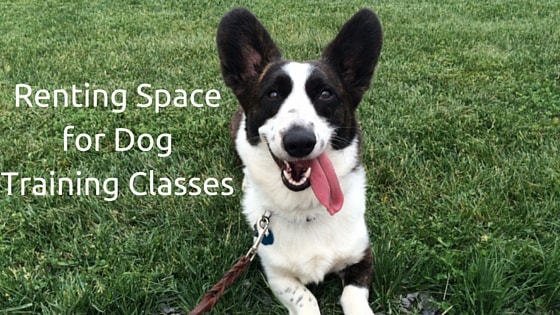
Should you make the leap to a permanent facility?
Whether you’re a veteran or just starting out, there’s no doubt you’ve dreamed of having your own dog training facility. You’ve imagined the space, the flooring, and the equipment surrounded by happy, smiling dogs and clients, but should you make the leap? Here’s 5 things to consider before you sign the lease.
Can you afford it?
Your name is on the lease, so you are responsible for the entire amount of the rental costs. If you’re planning on bringing in outside help, rent out a portion, or hold large events, all of that is in the future. Can you afford the rent if those things don’t pan out? Also note, a lot of leases include additional maintenance costs on top of the rent. These can be one annual payment at the end of the year or included in the monthly payments. Ask about additional costs, not just the amount of the rent.
Consider The Equipment
Sure, you can hold basic dog obedience classes on concrete in a barn, but that’s not why you’re getting your own space. The minute you decide to hold any type of sports training classes that include jumping you have to consider anti-fatigue flooring. Sporting equipment, tables and chairs, mats, barriers, and cleaning supplies will be needed before a client ever sets foot in the space. Don’t forget a sign. You’ll need a nice sign out front to let everyone know you’re there! Make a list and add it all up using an average cost from one Google search. Yes, you’ll find discounts and sales on some things, but you don’t want to count on being able to do that for every item.
Insure The Facility
Now that you’ve got the building and all your stuff, you need to insure it all. The building owner will have some requirements for the minimum coverage needed for you to get in the door. If you’re bringing in help or subcontractors you’re going to need liability for those people as well. You’re probably going to purchase your equipment in stages, but what if it all suddenly goes away in a fire? You’re going to need the coverage to get back up and running. The time to find out who pays for fixes from building breakage is before you sign the lease, not after. If a pipe bursts and ruins all your stuff who pays for it? Even if the building owner pays, how long will you be out of business while the repairs are being done? Take a look at insurance that covers loss of income should the unthinkable occur.
Will your city allow you to open?
Cities have zoning regulations so residential areas aren’t built right next to factories. Regulations say where certain businesses can and cannot open. Training businesses often fall between the cracks of zoning codes. You’re not exactly dog boarding and you’re definitely not a groomer, but sometimes cities put you in those zones because there isn’t a place for you. This means buildings you can consider are in a certain district and not necessarily where you want to be. One of your first phone calls should be to the City Planning department to find out where you can go. While you may be able get a conditional use permit for your perfect space, CUP’s require a lot of paperwork, time, and money to get. Plus, you also may be required to do some building upgrades as part of the conditions.
Will clients travel to you?
Sometimes what we can afford and where the city puts us isn’t exactly on Main Street. If you’ve found an old warehouse on the outskirts of town, will people drive to meet you? Sure, existing clients love you and may drive the extra 15 minutes to get to you, but what about people who don’t love you yet? When someone does a map search for your location will they think, “Oh heck no?” Will they drive it in evening traffic? Rain? You need a location people are willing to go to.
Consider these five places to hold group dog training classes before you decide to run your own facility.
Did we miss something? What else should be considered before signing a lease? Tell us in the comments!
Get Dog Training Business Tips!
Receive valuable dog training business tips and resources every month! Subscribe to The Modern Dog Trainer now by submitting your name and email below.
[mc4wp_form]
![Three Ways To Build Your Client and Networking Base]()
by Erin Bessey | Dec 27, 2014 | Business
Doggy Day Care can be a quick fix for a lot of dogs with energy problems but it isn’t right for all dogs. It is important that a day care properly screen dogs before taking them in for group play. The wrong dog can throw off the whole dynamics of a good play group. Here are 5 reasons that a dog may not be an appropriate candidate for doggy day care.
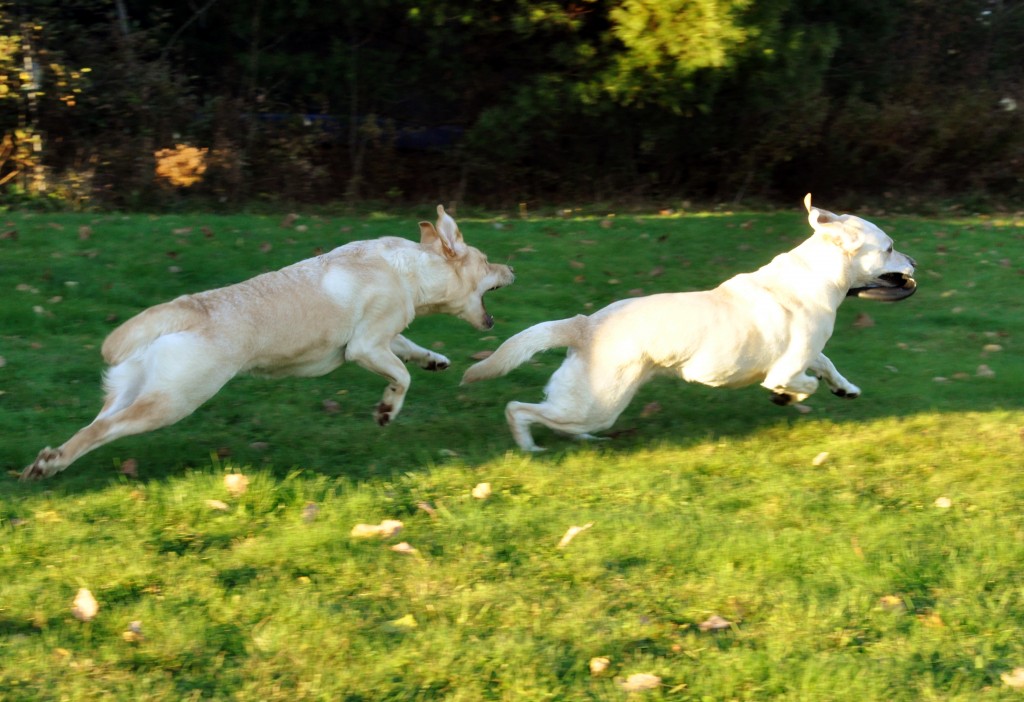
Image by Erin Bessey
5 Reasons Not to Send A Dog To Doggy Day Care
1. Undersocialized
As Patricia McConnell has said, “dogs have different personalities and have had different experiences while growing up.” Depending on the experiences the dog has had growing up, he may not have had enough positive experiences with other dogs. Because of the lack of socialization many clients want to send their dog to daycare to overcome their fear. A fearful dog, however, forced into a group of dogs could become more reactive. Research shows dogs that tuck their tail are 50% more likely to respond aggressively if they are pushed.
2. Bully On The Playground
Some dogs go to daycare and, while they enjoy it themselves, they are making it a terrible experience for others. The daycare bully tends to overwhelm dogs they are playing with by mowing over them, harassing others that have toys and picking on the shy dog.
3. Dogs That Lack Good Social Skills
This could be the dog that is shy and doesn’t know how to appropriately convey that to other dogs and lashes out aggressively. It could also be the dog that fits #2 that doesn’t know how to properly read another dog’s calming signals and may continue to annoy others with their intensity or energy.
4. Easily Overstimulated
The idea behind daycare is to provide a dog with an outlet for their energy. At the end of the day when you pick up the dog he should be pleasantly exhausted. If a dog is easily stimulated, too many days of daycare might have the opposite effect and keep a dog in “go” mode meaning he is full of adrenaline and come home amped up instead of calm. Sending a dog a couple of times a week instead of all 5 days keep the dog from being over stimulated.
5. Does the Dog Want It or Does The Owner Want It?
Dogs that don’t enjoy the company of other dogs could find the daycare experience very unpleasant and further their dislike for other dogs. It may be clear that a dog does not enjoy the day care experience if he repeatedly exhibits inappropriate, anti-social behaviors towards other dogs.
Dogs at different times may exhibit one of these 5 reasons. When it becomes a problem is when they are repeated. Like people, dogs have bad days, but something will need to change if the behaviors listed above continue to show on a regular basis at day care. It might be as easy as switching up the play groups or reducing the number of days the dog goes to day care. Fortunately an appropriate facility will have good training in reading dog body language and will be able to identify the dog that doesn’t belong. Robin Bennett has some great resources for doggy day care businesses.
Get Dog Training Business Tips!
Receive valuable dog training business tips and resources every week! Subscribe to The Modern Dog Trainer now by submitting your name and email below.
[mc4wp_form]
![Three Ways To Build Your Client and Networking Base]()
by Erin Bessey | Dec 8, 2014 | Business

Why Doggy Day Care Is A Good Idea
It seems like a great solution to many trainers to recommend doggy day care to the average client. Many dogs lack stimulation, sufficient outlets for their energy, or opportunities to socialize with other dogs. Here are five reasons why you might consider sending a dog to doggy day care – or starting a doggy day care yourself.
1. Exercise & Socialization
Daycare provides the dog with play times throughout the day to express normal doggy behavior. They have the opportunity to meet and play with new dogs and learn how to properly socialize and interact with other dogs. Naturally, day cares run differently. Some provide dogs access to each other all day long for endless play while others have set play times and playgroups for the dogs.
2. Human Contact
During the day while the owner is away at work, the dog doesn’t have to stay home alone. The staff members of the day care interact with the dogs regularly. They are there to interact during play if the dog desires, treats during quiet times, or a good ol’ scratch behind the ear and cuddles.
3. Expert-Supervised Playtime
Often owners themselves are not comfortable monitoring play between dogs. They aren’t familiar with what is appropriate and what is dangerous. A proper daycare has experienced staff that have had training to interpret dog body language so they can ensure all the dogs are comfortable.
4. Relief From Boredom
Crates get a bad reputation sometimes from pet owners. They don’t want to leave their dog crated while they work or when they aren’t home. Not utilizing a crate and establishing good house habits can potentially set the dog up for destructive behaviors when alone. To compromise, owners can send the dog to daycare where they will have plenty of stimulation and opportunities to prevent any boredom.
5. A Good Solution For Busy Owners
Some owners feel guilty for working more than 8 hours and leaving their dog at home. Day care will allow the dog multiple opportunities to potty and be entertained while the owner is away.
It is essential to take the dog’s personality and temperament in to consideration when deciding if doggy day care is right for the dog. The five reasons above list some benefits to day care but day care isn’t for all dogs. Robin Bennett is an outstanding resource for dog-dog interactions and an expert in running great doggy day cares. Check out her articles on doggy day cares here.
Stay tuned for a follow-up article on reasons why some dogs shouldn’t attend doggy day care.
Get Dog Training Business Tips!
Receive valuable dog training business tips and resources every week! Subscribe to The Modern Dog Trainer now by submitting your name and email below.
[mc4wp_form]
![Three Ways To Build Your Client and Networking Base]()
by Thomas Aaron | Dec 5, 2014 | Business
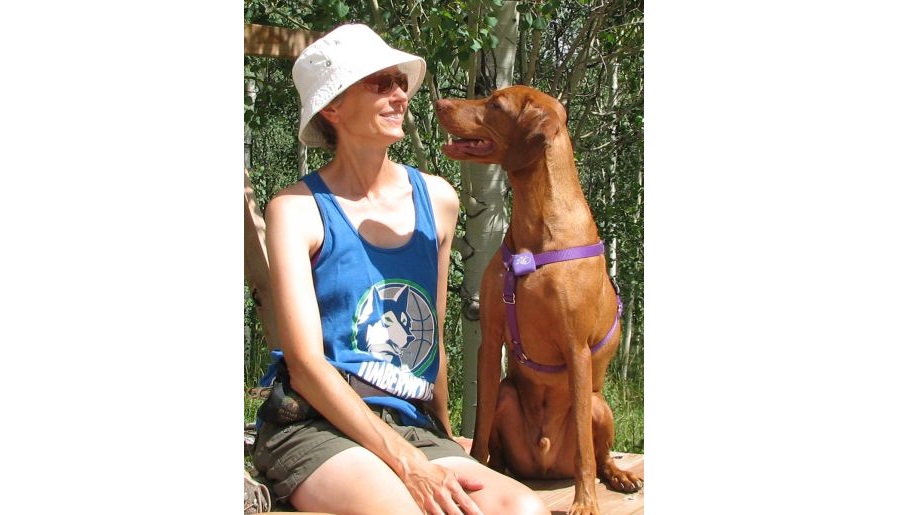
Copyright The Light Of Dog LLC. All Worldwide Rights Reserved.
An Interview With Sue Brown On Writing A Dog Training Book
Writing a book about dog training can help you to establish yourself as an industry authority in your community and beyond. But what does it take to write a book? We asked Sue Brown, an accomplished dog trainer and author of Juvenile Delinquent Dogs: The Complete Guide to Saving Your Sanity and Successfully Living with Your Adolescent Dog and Ask the Trainer to talk to us about her own experience as an author.
When it comes to dog training in Denver, Colorado, Sue Brown sets a standard of professionalism that serves as a model for the up-and-coming trainers in her community and makes her a trusted colleague of the more experienced trainers. She holds certifications through the International Association of Animal Behavior Consultants and the Certification Council for Professional Dog Trainers. She also is a Canine Good Citizen (CGC) evaluator, and is the co-founder of the Colorado Dog Trainers Network, a networking and training organization for Colorado dog trainers.

Copyright The Light Of Dog LLC. All Worldwide Rights Reserved.
The Modern Dog Trainer: You have written two books, Juvenile Delinquent Dogs and Ask the Trainer. Why did you decide to write these books?
Sue Brown: I wanted to find a way to share my knowledge and experience with a wider audience. In addition, I had known I wanted to write a book for a long time. I enjoy writing and I wanted to do something more in-depth than you can do with a blog. The only thing holding me back was determining the right topics. Once I had an idea I was passionate about, I got started!
TMDT: Why did you choose those particular topics?
SB: I wanted to write a book that had not already been done several times over. As I scoured through the available books, I noticed there were tons of books about puppies and about dogs in general but none about adolescent dogs. And most books are written from the perspective of a “textbook” sort of approach. I wanted something different. My training clients have always appreciated the personal stories I shared about my own dogs, so I wanted to take on a new topic from the perspective of going through the process with my own dog. So I wrote Juvenile Delinquent Dogs as I was raising my Vizsla, Romeo. He gave me plenty of stories to share! As for Ask the Trainer, it was a way for me to compile and share the articles I had been writing for several years that cover a wide variety of topics.
TMDT: How long did it take you to write each of your books?
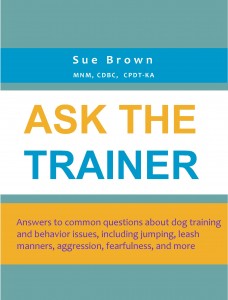
Copyright The Light Of Dog LLC. All Worldwide Rights Reserved.
SB: The initial draft of Juvenile Delinquent Dogs took one-and-a-half to two years. That was due in part to the fact I was writing it as I was raising Romeo and I wanted to cover that entire process as it was fresh in my mind. In addition, my clients knew I was writing the book, so they kept giving me more ideas to add. The edits and re-writes added another several months.
Ask the Trainer was a compilation of articles I had written over time for a rescue group newsletter, so that was written in stages over several years.
TBDT: What was the most fulfilling thing about writing your books?
SB: I have always loved to read. As a child, I could sit and spend an entire afternoon reading a book from start to finish. So it was very fulfilling to see an actual book that I had written myself!
TBDT: What was the most difficult thing about writing your books?
SB: I had intended Juvenile Delinquent Dogs to be around 150-200 pages, but it ended up being much longer because there was so much I wanted to share. Even as a student, I always had trouble keeping my written essays short! The hardest part was deciding when to stop. I still think of things I wish I had been able to include. I am happy with the length of it, as it is intended to be a reference book for those living with dogs. I don’t expect people to read it cover to cover in one sitting. It’s meant to be kept handy so it can be referred to over and over again.
TBDT: How do you use your books to augment the dog training you do in your community?
SB: Some people who contact me cannot afford the training that would be most beneficial, so the books are a chance to gain a lot of information and have the ability to go back to it over and over again. Other people will participate in group classes or private training and buy the book to supplement our training together so that they can go back and take time to absorb what we have covered in person. Studies show that people will forget 90% of what they have heard within a week. The books are a way to have that information handy and be able to go back to it at any time.
TBDT: Why did you choose self-publication over traditional publication with a company like Dogwise?
SB: I love to learn, and being able to self-publish and handle that entire process myself was a great learning experience. I certainly made mistakes and would do some things differently next time around. But I am also a Type-A personality, and I knew I wanted control over the entire process. This was my “baby” and I wanted it to be exactly what I wanted!
TBDT: Your first book, Juvenile Delinquent Dogs is available in hard copy and e-book formats, and your second book, Ask the Trainer, is available only in e-book format. What were your reasons for those format selections?
SB: E-books are very popular now, and there are many benefits to them. But I still love being able to hold a book in my hands and carry it with me. So Juvenile Delinquent Dogs was always intended to have a print and e-book version to satisfy both types of people – those who still prefer to hold a book in their hands and those who prefer the economy and convenience of an e-book. For Ask the Trainer, I had seen everything it takes to produce a print version – and the expenses that go with it – and decided to stick with an e-book format for this book. This also gives me the option of easily revising it and adding new articles – which I have done several times already.
TBDT: What advice would you give to those who aspire to write their own books?
SB: My first piece of advice would be to choose a topic about which you are passionate. The process can be long and frustrating at times, so your passion will help you stick with it.
Next would be to talk to others who have done it so that you can avoid some of their mistakes. Also, be honest about how much time and effort you have to put into it. While I am glad I self-published, I honestly do not know if I would do that again. It took a long time and a ton of work, and I don’t know that I could put that much time into another book.
Finally, do not let doubts or anything else hold you back. If you’re passionate about it, go for it!
TMDT: You obviously have worked very hard on your professional certifications. Do you believe it is important for up-and-coming writers to hold dog training certifications?
SB: Our profession is unregulated, so it is very much a buyer-beware market. I believe independent certifications from reputable organizations are a way for us to begin setting standards, minimum qualifications and a set of ethics by which we all strive to abide. Many clients do not know to ask about qualifications, but I am seeing more and more who do. As it pertains to writers, I believe legitimate certifications help lend credibility and demonstrate a degree of expertise, especially for those whose names are not well-known.
TBDT: Can you give us a concise summary of your book-writing process?
SB: Yes, I do it like this:
- Outline your book. Consider what you will cover and how it will be laid out.
- Write it. Review it. Make revisions. Review it again. Make more revisions.
- Have a few people review it. I had 3-4 people review it for me and give feedback. Make revisions.
- Send it to an editor/proofreader. Make more revisions. Send back for re-review. Make more revisions.
- Send to a professional for layout and formatting.
- Determine your final title and design your book cover. Or work with someone to design it for you.
- Review it — and review it again — to ensure everything is perfect.
- Send it to printer.
- Don’t forget to work on your marketing during all of this as well!
- Figure out pricing. It will depend upon how much of this you do yourself and how much you pay others to do. If you are self-publishing, it is a lot more expensive because you are covering ALL of the costs, but you keep more of the profits as well. If you are working with a publisher, you share some costs, and you also receive a smaller percentage of sales.
TMDT: What is next in your book-writing career?
SB: I hope to get started on another book in 2015. You will have to wait to find out the topic!
If any of you have more questions for author Sue Brown, please let us know in the comments, and we will try to get them answered for you. We’d like to extend a BIG thank you to Sue for taking the time to answer our questions. Be sure to check out her books and ebooks!
Get Dog Training Business Tips!
Receive valuable dog training business tips and resources every week! Subscribe to The Modern Dog Trainer now by submitting your name and email below.
[mc4wp_form]
![Three Ways To Build Your Client and Networking Base]()
by Ines | Nov 25, 2014 | Business
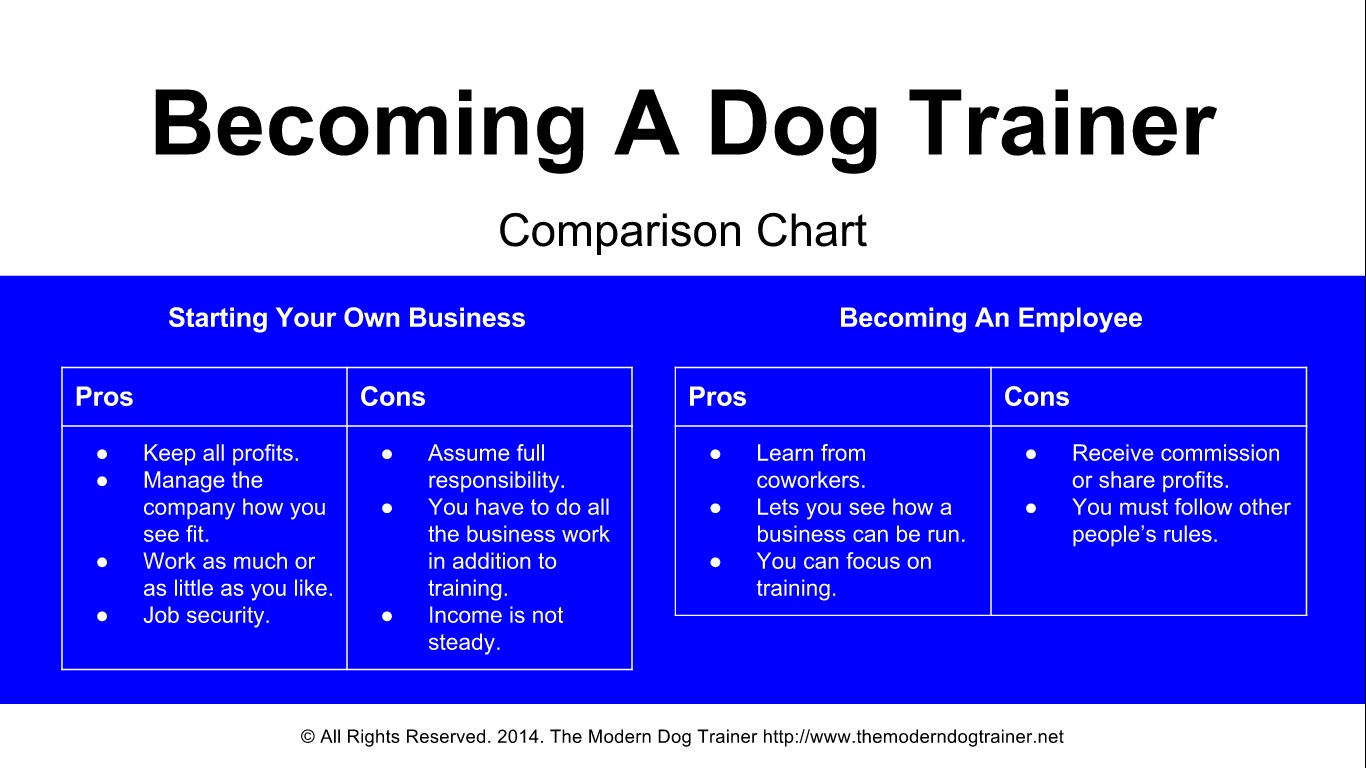
How To Choose Between Starting Your Own Business Or Becoming Someone’s Employee
When you are first starting out, it can be difficult to choose between starting your own dog training business or joining someone else’s. Ultimately, there are benefits to both.
Start Your Own Business
Many dog trainers choose to start their own business. Having your own business increases your revenue and lets you run the business how you see fit. However, having your own business also comes with more responsibility. You’ll need to purchase insurance, get the appropriate business licences, and maybe even start an LLC. The income isn’t always steady and you don’t have anyone to share the work load with. Fortunately, the job security is great because you are your own boss.
Starting your own business is the best way to make a decent wage as a trainer. It is more of a career path than an hourly or commission based job. However, there are some advantages to starting out with a regular job under someone else’s direction.
Get a Job
If you don’t know how to run a business, but are eager to get started training, getting a job is a great option. While working for someone else, you’ll be able to learn about how the administrative end of running a business looks like and you’ll be able to learn from the other trainers in the company. The down side is that you have less freedoms when it comes to working and you will have to survive off of commissions or hourly based pay. Many of the jobs that you will find are entry-level positions such as dog caretaker, kennel tech, or dog walker. Management level positions are quite rare. Getting a job is a great way to get a lot of experience under your belt. We’d like to encourage you to research companies that are willing to reimburse or fund continuing education or certifications.
If you are considering getting started as a dog trainer, check out DogTec’s free download, “Going to the Dogs?” There is some great information about what it takes to become a dog trainer.
Would you prefer to start your own business or join someone else’s company?
Recommended Article by The Modern Dog Trainer
![Three Ways To Build Your Client and Networking Base]()
by Thomas Aaron | Nov 17, 2014 | Business
Side Services Dog Trainers Can Offer To Boost Profits
If you are looking for a way to earn some extra income, adding some new services to your current offerings can increase your clientele, increase your profitability and ward off monotony. These are three potential side services dog trainers can offer and some suggestions about how you might market them. Each of these ideas easily deserves its own article — or even its own book — but the following information will help you see some of the possibilities available to you.
Lectures & Workshops
If you’ve been training dogs for a while, you probably have developed your own way of talking about various issues. Perhaps you have come up with unique analogies to describe dog training tasks or developed effective methods for solving tricky problems. Not only is your wisdom useful to the average dog owner, but even seasoned trainers can benefit from fresh perspectives on old problems. Alternatively, if you are shy about sharing your own wisdom, you can host a speaker from elsewhere to provide knowledge to your community. Either way, you position yourself as someone striving towards the cutting edge of dog training – and you can earn some extra money, too.

Michael Shikashio presenting at the 2014 APDT Conference.
There are some easy ways to advertise local lectures and workshops. Your own social network can be very useful for posting announcements (the more locally you can filter your announcement, the better). If you are already advertising your website, your advertising dollars will be more useful if your website has some interesting lectures listed on it. Also, local bulletin boards – particularly if they are in pet-industry establishments – can be a great way to make your community aware of your offerings.
Since lectures and workshops are meant for multiple attendees, it is a good idea to keep the price affordable for individuals and derive your profit from drawing a large audience. To provide some extra information on how a lecture could be set up, here is how one company describes its lectures to augment its dog training in Denver.
Dog Selection Assistance
Potential clients sometimes call to scope out dog training services before ever purchasing or adopting a dog. As a dog trainer, you already have a good feel for the factors that influence compatibility between dogs and families. Instead of just competing for their dog training business, become their advocate and help them find the right dog. This is a great way to earn extra money while practically guaranteeing yourself their dog training business once they finally acquire their new dog.
Of course, calls like those mentioned above are good opportunities, but there are other ways to make your community aware of your dog-matching service. In addition to making services known on your website and in your social networks (see above), you can capitalize on relationships you have with animal rescues and shelters. They typically are interested in placing animals in compatible homes and may be willing to let you offer your services through them. Additionally, well-networked dog trainers often receive news of available litters of puppies through breeders in their communities. Serious breeders are always concerned about their pups ending up in the right home, and they may be interested in using you to match up prospective owners with suitable puppies.
Pet Photography
If you are a good photographer and have access to a good camera, you can use your own skills and equipment to augment your income. After all, everyone loves a creative picture or an action shot of their dog. But if you don’t have the skills or equipment to close the deal, you can always partner with someone who does. Many up and coming photographers can be found on Craigslist and through local photography programs. They are often happy for an opportunity to build their portfolio and make a few bucks in the process.
Pet photography can be a great up-sell opportunity for your current and past clients, and great photos can end up in great referrals to your clients’ friends and family. In addition to offering it for the dogs you are currently training, consider scheduling a photo shoot at a local park through your social network and newsletter to bring in some extra money.
Another fantastic way to generate money through pet photography is by attending dog-related events with your camera. Make sure you have the technological capability and know-how to shoot great action shots if you attend agility, hunting, or other sporting events. You may have to peddle your pictures at these events when you first get started, but once your work becomes known, you can gain invitations to these events as their official photographer. This will generate great word of mouth advertising among the participants and increase your sales.
Photography prices vary wildly and they can get too expensive for your clientele pretty easily. Consider taking your – or your photography partner’s – skill level into account, along with the disposable income of the demographic you serve.
Hopefully these ideas will help you improve your offerings, your bottom line, and keep business exciting for you. At a minimum, it should provide food for thought and help you consider how you may better serve your own community of clients.
Please tell us what other services you think might be a good augmentation to dog training businesses in the comments below.















